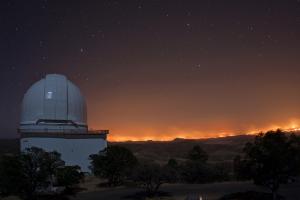Astronomical observatories often are surrounded by forests, which can create a fire hazard. In this view from 2011, for example, a fire encroaches on the telescopes of McDonald Observatory. Another fire threatened California's Lick Observatory in late 2020, and one burned several telescopes at Australia's Mount Stromlo Observatory in 2004. Earth's changing climate could make wildfires more common, posing a greater threat to astronomy. [Frank Cianciolo/McDonald Observatory]
You are here
Out of the Fire
Many observatories are built in beautiful locations — atop mountains, where they’re surrounded by trees and fields. The high ground puts them above much of Earth’s blurring atmosphere, giving them a sharper view of the universe.
But there’s also a downside to the locations: fires. In recent years, big fires have threatened, damaged, and even destroyed observatories.
The most recent threat came last August. A massive wildfire outside San Jose, California, threatened Lick Observatory. The fire was started by lightning. It consumed hundreds of square miles. And it almost got the observatory. Flames up to 200 feet tall advanced toward its telescopes. The fire destroyed a house on the property, and damaged a few other buildings. But the big domes and their telescopes survived.
Lick isn’t the only observatory to face the flames. In 2011, for example, our own McDonald Observatory was surrounded by a fire. The blaze eventually burned more than 300,000 acres, and forced the observatory to close. But controlled burns and other efforts kept the fire at bay.
An observatory in Australia wasn’t so lucky. A 2003 fire burned five telescopes, the administration building, and several houses and other structures. Only one telescope survived. The observatory has since been rebuilt.
Our changing climate is forecast to make wildfires even more common in the decades ahead — perhaps putting even more observatories in peril.
Script by Damond Benningfield
Get Premium Audio
Listen to today's episode of StarDate on the web the same day it airs in high-quality streaming audio without any extra ads or announcements. Choose a $8 one-month pass, or listen every day for a year for just $30.






